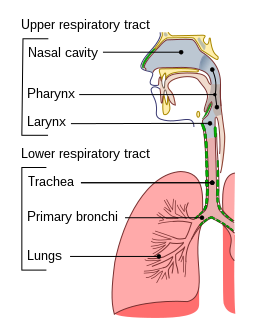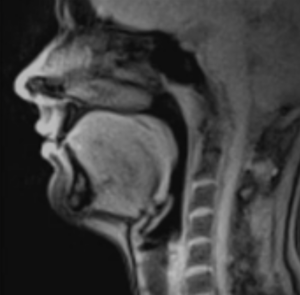6.2 Swallowing and Dysphagia
Swallowing
Before discussing how to support clients with their dietary needs, let us review the mechanism of swallowing. Swallowing is the transport of a substance from the mouth to the stomach. It is an important part of eating and drinking. The chewed food or drink that is moved in one swallow is called a bolus. The most common complications with swallowing are choking and dysphagia (Girdi-Papp, 2022).

The entire swallowing process takes about 4–8 seconds for solid food, and about one second for very soft food and liquids. Although this sounds quick and effortless, swallowing is a complex process that involves both the muscles of the tongue and the muscles of the pharynx and esophagus. It is aided by the presence of mucus and saliva. Swallowing consists of three phases — oral, pharyngeal, and esophageal — and involves many smooth muscles of the pharynx and esophagus. The oral phase is voluntary and controlled by the cerebral cortex, whereas the pharyngeal and esophageal phases are non-voluntary processes (Girdi-Papp, 2022).

Dysphagia
Dysphagia is difficulty in swallowing. It can have various causes and involve different parts of the swallowing mechanism or anatomy. Dysphagia frequently produces coughing, choking, or pulmonary aspiration and subsequent aspiration pneumonia. Dysphagia can also lead to dehydration and weight loss (Girdi-Papp, 2022). There are two types of dysphagia: oropharyngeal and esophageal.
Oropharyngeal dysphagia includes difficulty controlling the position of food in the mouth, difficulty initiating a swallow, nasal regurgitation, and a gurgling voice after swallowing. Clients identify the mouth or neck as the site of the problem. These problems are common among older individuals, and clients who have had strokes, head and neck cancer, and progressive neurologic diseases like Parkinson’s disease, Alzheimer’s disease, or multiple sclerosis (Girdi-Papp, 2022).
In esophageal dysphagia, clients indicate an inability to swallow solid food, saying that it is held up or stuck before it reaches the stomach or is regurgitated. Various diseases in or adjacent to the esophagus can result in dysphagia, and the treatment depends on the cause (Girdi-Papp, 2022). There are several triggers that can cause a client to have difficulty swallowing, so it is important to know what the signs of dysphagia are and ask yourself:
- Is the diet the right texture?
- Is the fluid the right consistency?
- Is the client positioned correctly?
- Are the bites and drink the right size?
- Is the client eating too fast?
- Does the client need adaptive utensils?
If the answer is “yes” to any of the above questions, either intervene and self-correct where appropriate, and consult with the care team to discuss the need for a reassessment of the client’s care plan.
Many treatments are used in dysphagia because it is not a disease, but a symptom or condition associated with a wide variety of diseases. Treatments can include swallowing therapy, dietary changes, feeding tubes, certain medications, and surgery.
Watch the video Understanding Dysphagia by Nestlé Health Science Canada (2011) on YouTube.
Choking
Choking is a life-threatening medical emergency that occurs when the air passage into the lungs is blocked by food or another object. This obstruction can be partial or complete. The disruption of normal breathing by choking hinders oxygen delivery to the body, resulting in asphyxia. Although oxygen stored in the blood and lungs can keep a person alive for several minutes after breathing stops, choking is potentially fatal. It is a major cause of unintentional injury-related death (Girdi-Papp, 2022).
Deaths from choking most often occur in the very young (< 1 year old) and in older adults (> 75 years). The obstruction of the airway most commonly occurs at the pharynx or trachea. Foods that can adapt their shape to that of the pharynx, such as bananas, marshmallows, or gelatinous candies, are particularly dangerous. Choking is frequently caused by tumours, swelling of the airway tissues due to infections, and neurological disorders (Girdi-Papp, 2022). Complications of choking include:
- Brain damage, which typically occurs if the body is deprived of air for 3 minutes.
- Death, which will usually occur if breathing is not restored in 6–8 minutes.
Causes
Children younger than age three are especially at risk of choking because they explore the environment by putting objects in their mouth. Their airway is smaller in diameter than an adult’s airway, and their coughing may not be as effective as that of an adult in clearing an airway obstruction. However, choking in adults is most often caused by food. Risk factors include:
- Medical conditions that affect the coordination of swallowing, such as:
- Strokes
- Parkinson’s disease
- Alzheimer’s disease
- Using alcohol or sedatives
- Undergoing a procedure involving the oral cavity or pharynx
In the prevention of choking in clients with dysphagia, the appropriate selection of food items with smaller particle sizes, smoother texture, and fluidity can reduce the risk.
The transport of a substance from the mouth to the stomach.
A ball-like mixture of food and saliva that forms in the mouth during the process of chewing.
Difficulty swallowing. Oropharyngeal dysphagia is difficulty controlling the position of food in the mouth, initiating a swallow, and nasal regurgitation. It is common to hear a gurgling voice after swallowing. Esophageal dysphagia is the inability to swallow solid food as food becomes stuck in the esophagus.
A condition in which foods, stomach contents, or fluids are breathed into the lungs through the windpipe/trachea.
Pneumonia is an infection in the lungs and large airways that causes inflammation (swelling). Aspiration pneumonia happens when food or liquid is breathed into the airways or lungs, instead of being swallowed.
The inability of a person to acquire sufficient oxygen through breathing for an extended period of time. Asphyxia can cause coma or death.

